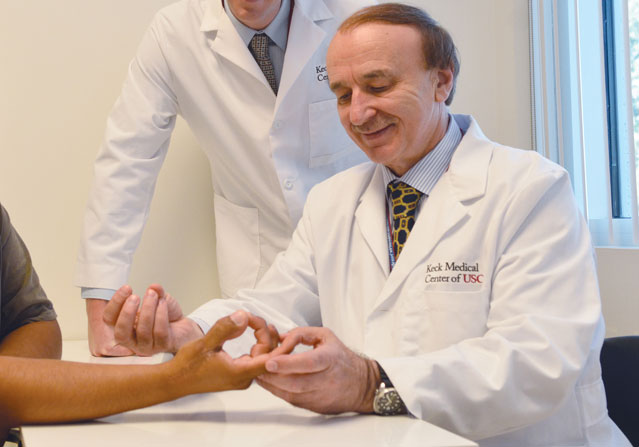
The grateful mother of one of his young patients recently sent Milan Stevanovic, MD, a photo of her son playing the trumpet. The photo is more than a memento — rather, it is a testament to the power of microsurgery.
A poorly-treated broken arm had left the boy unable to properly flex the fingers in his right hand, and unable to play the instrument that he loved.
Utilizing two microsurgical techniques, a free functional muscle transfer and a nerve transfer, Stevanovic, professor of orthopaedic, hand, and microsurgery at the Keck School of Medicine, was able to transplant muscles and nerves from the child’s leg to the child’s forearm. The surgery restored both function and feeling to the child’s hand, allowing him to once again make music.
“No surgical technique has improved patient treatment so much as microsurgery has in recent years,” says Stevanovic, who is also director of the Joseph H. Boyes Hand Fellowship program, thanks to technological advancements on several fronts.
Sutures that are five times thinner than a human hair and powerful microscopes that allow for magnification up to 50 times what the naked eye can see have made it possible for surgeons to perform incredibly refined work. They can now transplant different tissues from one part of the body to another, connecting tiny blood vessels that are half a millimeter in size.
Microsurgery allows surgeons to save limbs of some cancer patients and can help restore function to hands and feet previously damaged by trauma, breaks and burns. It can be used to give function to children born with shortened muscles that prevent them from properly using their limbs. Microsurgery can literally put a smile back on the face of someone suffering from facial palsy by restoring function to their facial muscles.
Stevanovic is a leading expert in free functional muscle transfers. His earliest research was in this field and he has since been expanding the application of and refining this technique. Free functional muscle transfer is a procedure in which muscles, nerves, and vessels are transplanted from one part of the body to another in order to restore lost motor function.
“It is amazing what can be done now,” explains Stevanovic, who has earned an international reputation in microsurgical procedures on the extremities — shoulders, elbows, hands, and legs.
Stevanovic made a splash in the microsurgery world 30 years ago when he performed a toe-to-thumb transplant, a rare and delicate procedure that involves reconnecting all the tiny vessels, nerves, and muscles to give the patient a working opposable digit.
“We see patients who have no motion in their hand or their elbow before surgery,” says Stevanovic. “You should see their faces after surgical treatment. It is just incredible.”
By Hope Hamashige